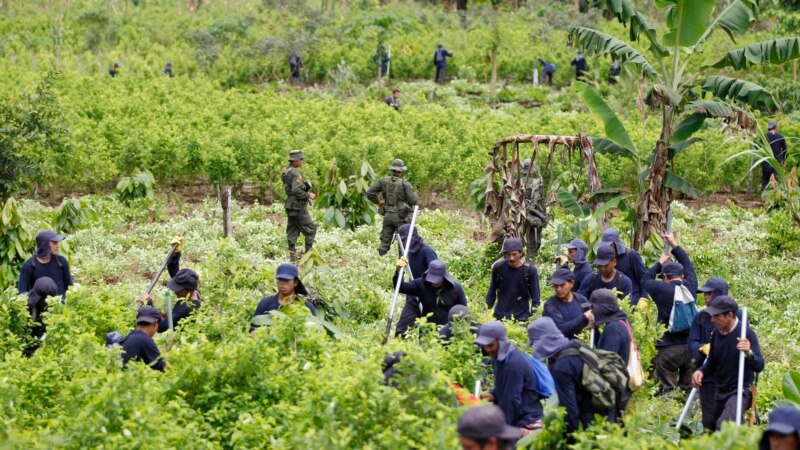
The administration of President Joe Biden has quietly abandoned a key indicator used for decades to measure success in the fight against drugs, by suspending satellite monitoring of coca crops in Colombia amid a surge in cocaine production in South America. .
A State Department spokesperson called the measure “temporary” but did not give a timeframe for the resumption of data collection or explain why it was suspended. It is also not known whether satellite studies will continue in Peru and Bolivia, which together account for approximately half of the coca production in the Andean region.
The move, first reported by Colombia’s El Tiempo newspaper, has sparked outrage among Florida congressional Republicans, who have been urging the president to decertify the Colombian government for failing to cooperate with the US counternarcotics fight. But it coincides with leftist Colombian President Gustavo Petro’s campaign to refocus police activities away from rural backwaters where coca is grown, and instead go after the large-scale drug traffickers and money launderers who reap most of the profits. of drug trafficking.
“We are constantly evaluating the effectiveness of various counternarcotics measures and making changes to our work as necessary,” the US State Department spokesman said in an emailed statement. The spokesman made the remarks on condition of anonymity, because those are agency policies. “We continue to work with the Colombian government to monitor illicit coca crops.”
Since at least 1987, the US government has published annual estimates of coca cultivation in Colombia. The numbers soared to an all-time high in 2020, when the Office of National Drug Control Policy estimated that 650,000 acres of land—an area equivalent to three times the size of New York City—had been planted with the crop. drug used to make cocaine. Last year’s report revealed that production was almost unchanged in 2021 from the same high level.
In the first five months of 2023, the Petro government has manually eradicated just 4,511 hectares of coca, almost 90% less than the 33,454 hectares where the crop was eradicated during the same period a year ago, when the conservative president Iván Duque was still in power.
While US authorities have not commented on what prompted the policy change, Republicans have used it to attack Petro, a former guerrilla, as he seeks to improve ties with Venezuela’s socialist government and tries to reach an agreement with the National Liberation Army, the last leftist insurgency still operating in Colombia.
“This is a gift to the Petro government,” Florida Sen. Marco Rubio, vice chair of the Senate Select Committee on Intelligence and senior member of the Foreign Relations Committee, said in a statement to The Associated Press. “It is another example of the Biden administration giving concessions to far-left governments in the region.”
Petro has pushed back against such criticism, arguing that the United States would do well to refocus its attention on the fentanyl crisis, which is blamed for tens of thousands of overdose deaths.
“Things change,” he wrote in a tweet this week in response to attacks by Rep. María Elvira Salazar, a Miami Republican who chairs the House Foreign Affairs Committee. Without directly addressing questions about the future of US coca monitoring, she said that “the structure of narcotics consumption is changing for the worse, reducing the demand for cocaine, which is beginning to flow to other parts of the planet.” .
Adam Isacson, director of defense oversight for the Washington Office on Latin America, said satellite monitoring of coca crops offers valuable insight into Colombia’s ability to reassert state control in remote and economically depressed areas that by far They have long been controlled by illegal armed groups.
But as a tool for estimating cocaine flows it is less reliable than other measures that have remained largely stable in recent years, such as data on cocaine purity, street prices and overdose deaths. In addition, the United Nations, in conjunction with the Colombian authorities, annually conducts its own survey on coca cultivation, which combines satellite data with ground verification.
Still, he suspects that politics may have also played a role in the US decision to suspend operations.
“If you put a lot of weight on the hectares, you are headed for a collision with the Petro government, which does not want to make eradication the center of its anti-narcotics strategy,” he explained. “The United States may be calculating that it doesn’t need such a big irritation with its closest military ally in the hemisphere.”
The Biden administration has carefully tried to minimize political differences with Colombia’s first leftist government on narcotics, trade, negotiations with armed rebel groups, and sanctions on Venezuela’s socialist government, emphasizing instead the more than two decades of close bilateral cooperation.
The diplomatic strategy has yielded some positive results. Petro visited the White House in April and spoke with Biden about a common agenda to combat climate change and address migration. A few days later, Washington announced that it would open an immigration processing center in Colombia to deal with a growing number of migrants from Venezuela and other parts of South America trying to enter the United States.
“We are going down the same river, a river that leads to ever greater democracy and ever greater freedom,” Petro said at the White House.
The spokesman for the US State Department asserted that interrupting cocaine trafficking remains a “high priority” because it fuels violence, crime and death throughout the hemisphere.
The White House’s office for coordinating drug policy, which publishes a report on coca crop monitoring each July, did not respond to a request for comment.
Connect with the Voice of America! Subscribe to our channel Youtube and activate notifications, or follow us on social networks: Facebook, Twitter and Instagram.














